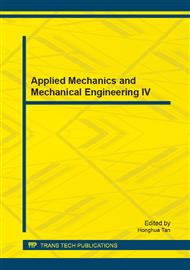[1]
Military handbook material deterioration prevention and control, Guide of army material, part one, Metals (Mll Hdbk-735 (MR), U.S.A. Department of Defense; (1993).
Google Scholar
[2]
W. Beech, and J. Sunner: Biocorrosion: Towards understanding interactions between biofilms and metals, Current Opinion in Biotechnology, Vol. 15, no. 3 (2004), pp.181-186.
DOI: 10.1016/j.copbio.2004.05.001
Google Scholar
[3]
W. Keevil: The Physico-chemistry of biofilm-mediated pitting corrosion of copper pipe supplying portable water, Water Science and Technology, Vol. 49, no. 2 (2004), pp.91-98.
DOI: 10.2166/wst.2004.0096
Google Scholar
[4]
B. Webster, S. Werner, and P. Bremer: Microbiologically influenced corrosion of copper in portable water systems- PH effects, Corrosion, Vol. 56, no. 9 (2000), pp.942-950.
DOI: 10.5006/1.3280598
Google Scholar
[5]
R. Oliphant: Causes of copper corrosion in plumbing systems, Foundation for Water Research 2003, UK.
Google Scholar
[6]
B. Zietz, H. Dieter, M. Lakomek, H. Schneider, B. Kessler-Gaedtke, and H. Dunkeberg: Epidemiological investigation on chronic copper toxicity to children exposed via public drinking water supply, Science of the Total Environment, Vol. 302, no. 1-3 (2003).
DOI: 10.1016/s0048-9697(02)00399-6
Google Scholar
[7]
P. Xu, S. Huang. Z. Wang, and G. Lagos: Daily intakes of copper, zinc and arsenic in drinking water by population of shanghai-China, Science of the Total Environment, Vol. 362, no. 1-3 (2006), pp.50-55.
DOI: 10.1016/j.scitotenv.2005.05.022
Google Scholar
[8]
T. Aastrup, M. Wadsak, C. Leygraf, and M. Screiner: In situ studies of initial atmospheric corrosion of copper: Influence of humidity, sulfur dioxides, ozone and nitrogen dioxide, Journal of Electrochem Soc., Vol. 147, no. 7 (2000), pp.2543-2551.
DOI: 10.1149/1.1393566
Google Scholar
[9]
H. Strandberg: Perspective on bronze sculpture conservation, modeling copper and bronze corrosion, Ph. D Thesis, Dept. Inorganic chemistry, Goteborg University, Sweden, (1997).
Google Scholar
[10]
Z. Y. Chen: The role of particles on initial atmospheric corrosion of copper and zinc- lateral distribution, Secondary spreading and Co2/So2 influence, Ph.D. Thesis, School of Industrial Engineering and Management, Royal Institute of Technology, Sweden, (2005).
Google Scholar
[11]
K. Ismail, and S. Abdelfatah: Effects of Zn and Pb as alloying elements on the electrochemical behavior of Brass in Borate Solutions, J. Appl. Electrochem, Vol. 31 (2001), pp.663-670.
Google Scholar
[12]
J. Morales, G. Fernandez, S. Gonzalez, P. Esparza, R. Salvarezza, and A. Arvia: A comparative study of passivation of α-brass and β-brass in Borate Buffer Solutions Containing Sodium Chloride: The Effect of Temperature, Corrosion Science., Vol. 40, no. 1-3 (1998).
DOI: 10.1016/s0010-938x(97)00111-x
Google Scholar
[13]
A. Shim El-Din, J. Abd El-Khade, and M. Badran: Galvanic corrosion in the copper/zinc system: I. Potential distribution in relation to the nature of cathode and to the type of anion in solution, Br. Corrosion J., Vol. 16 (1981), pp.32-37.
DOI: 10.1179/bcj.1981.16.1.32
Google Scholar
[14]
D. Mcdonald, B. Syrett, and S. Wing: The corrosion of copper-nickel alloys 706 and 715 in flowing sea water: I. effects of oxygen, Corrosion, Vol. 34 (1977), pp.289-301.
DOI: 10.5006/0010-9312-34.9.289
Google Scholar
[15]
A. Mendoza, F. Corvo, A. Gómez, and J. Gómez: Influence of corrosion products of copper on its atmospheric corrosion kinetics in tropical climate, Corrosion Science, Vol. 46 (2004), pp.1189-1200.
DOI: 10.1016/j.corsci.2003.09.014
Google Scholar
[16]
I. Milosev, and M. Metikos-Hukovic: Passive films on 90Cu-10Ni Alloy: The mechanism of breakdown in chloride containing solutions, J. Electrochem. Soc., Vol. 138, no. 1 (1991), pp.61-67.
DOI: 10.1002/chin.199109016
Google Scholar
[17]
A. Srivastava, and R. Balasubramaniam: Microstructural characterization of copper corrosion in aqueous and soil environments, Materials Characterization, Vol. 55, no. 2 (2005), pp.127-135.
DOI: 10.1016/j.matchar.2005.04.004
Google Scholar
[18]
J. Sandberg, I. Wallinder, C. Leygraf, and N. Le Bozec: Corrosion induced copper runoff from naturally and pre-painted copper in marine environment, Corrosion Science, Vol. 48 (2006), pp.4316-4338.
DOI: 10.1016/j.corsci.2006.04.004
Google Scholar
[19]
B. Kuźnicka: Erosion–corrosion of heat exchanger tubes,: Engineering Failure Analysis, Vol. 16, no. 7 (2009), pp.2382-2387.
DOI: 10.1016/j.engfailanal.2009.03.026
Google Scholar
[20]
I. Vargas, M. Alsina, P. Pasten, and G. Pizarro: Influence of solid corrosion by-products on the consumption of dissolved oxygen in copper pipes, Corrosion Science, Vol. 51 (2009), pp.1030-1037.
DOI: 10.1016/j.corsci.2009.02.014
Google Scholar
[21]
A. Dodek: Influence of the operating condition on copper pipe corrosion, Ph.D. Thesis , Dept. Material Engineering, University of Zilina, Slovak Republic. (2011).
Google Scholar


